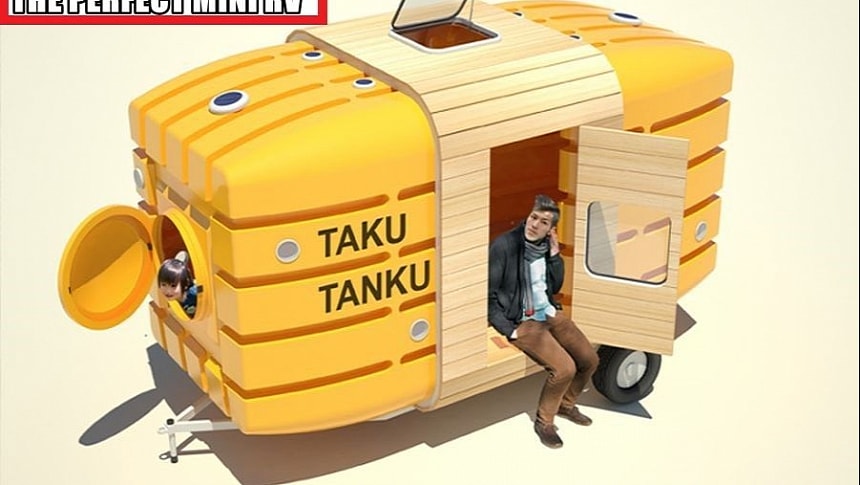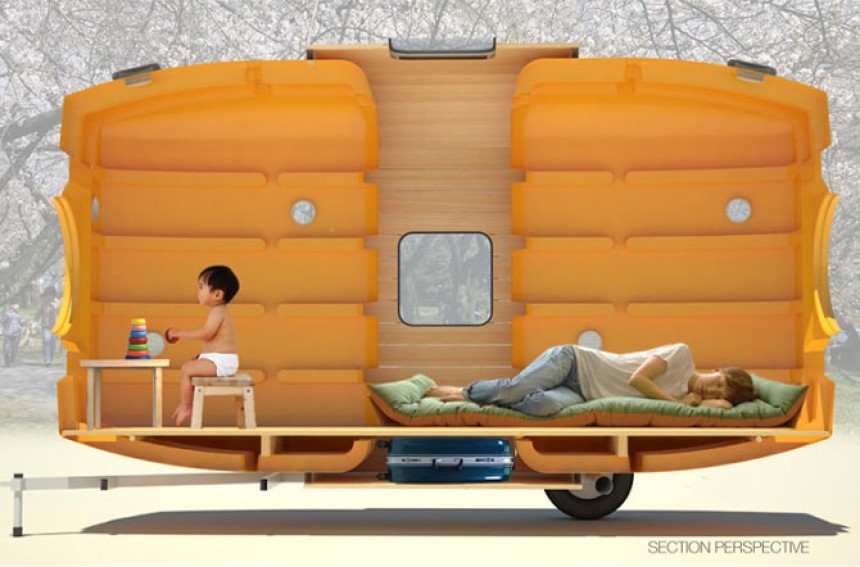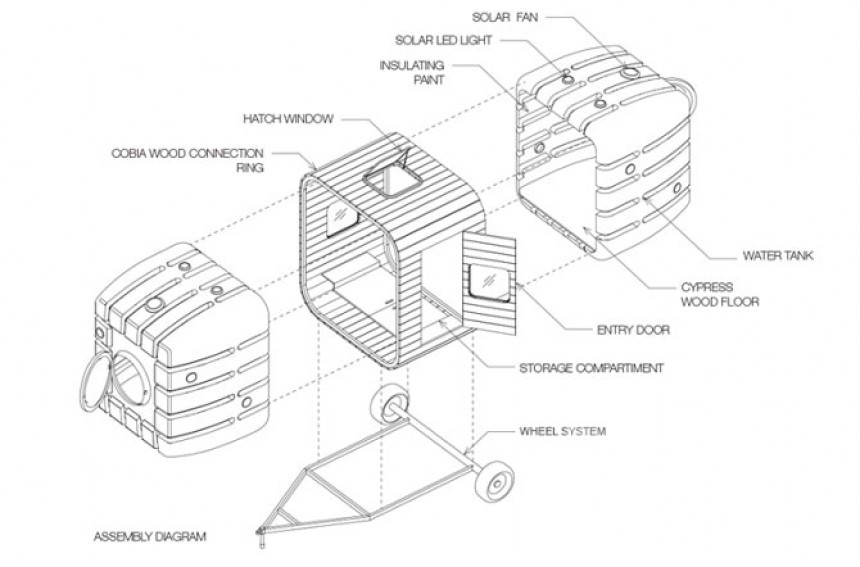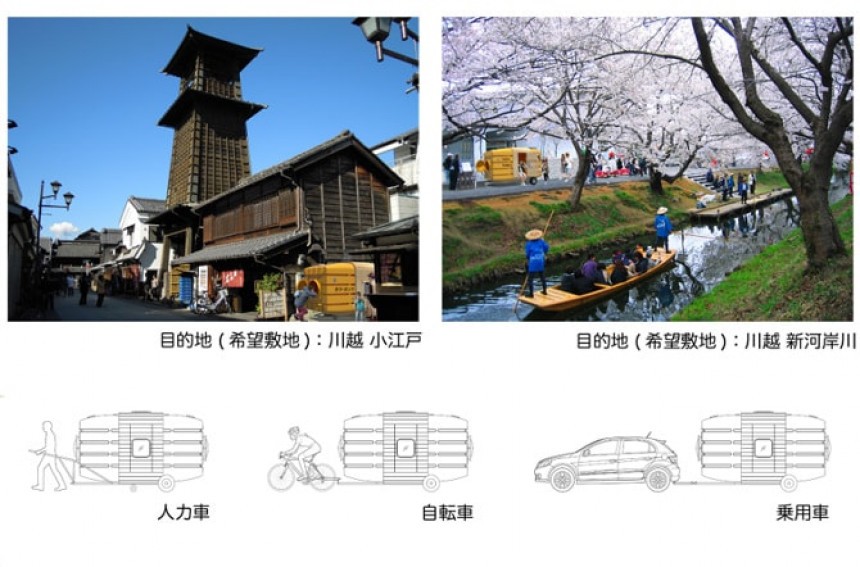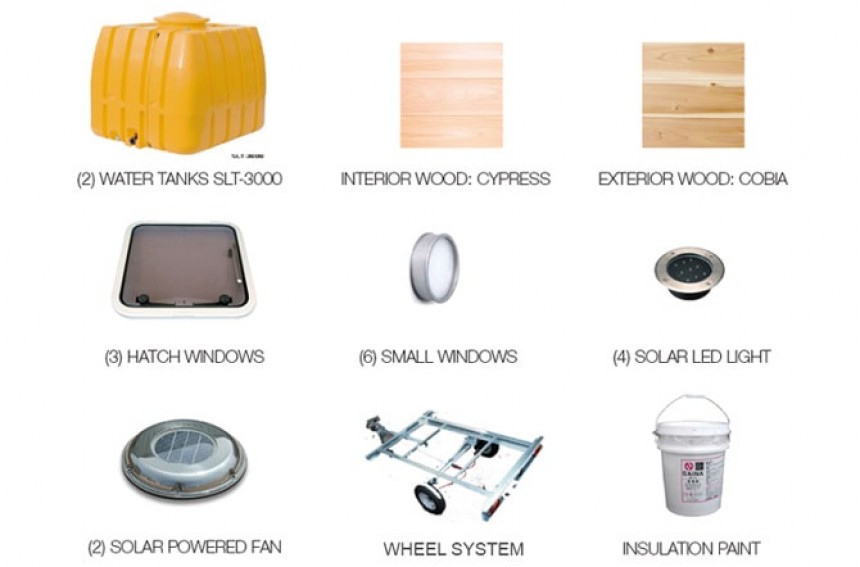How much downsizing can you do before your tiny home loses all justification of being called a "home"? If today's proposal for a Blast from the Past story is any indication, the answer to that question is: a lot of it.
Designed for leisure, performance, or micromobility, bicycles aren't necessarily envisioned as vacation vehicles – unless, of course, your idea of the perfect vacation entails bikepacking on scenic routes, which is perfectly fine. But that's not to say that they couldn't serve as towing vehicles for micro-RVs with all the functionality of their larger counterparts.
These past few years have seen a spike in the number of mass-produced bike trailers as upgraded options to traditional bikepacking. The rise in popularity of electric bicycles, which bring motor assistance and thus enhanced capability to ride farther than on a traditional pedal-powered bike, played a significant part in this. After all, when you have the motor making riding easier for you, why not add a trailer to extend the outing for at least one night?
Despite the boom in popularity, bike trailers and bike campers remain niche products. Those that do make it to market as mass-produced units are ridiculously expensive, while DIY (do it yourself) units require at least minimal skills and plenty of free time – as well as the willingness to spend that time in the shop, working on such a project. The Taku-Tanku would have bridged the gap between the two.
The Taku-Tanku is a bike trailer that, for one impressive newscycle, held the title of the world's lightest tiny house. It's the perfect candidate for a Blast from the Past story, given the incredible attention mobile homes of all shapes and sizes get, and especially if you consider how it would have changed the game if it had made it into production.
The Taku-Tanku was designed as an entry in a competition on tiny houses and sustainable mobile homes in 2014. It's the brainchild of architect Marcelo Ertorteguy, fashion designer and architect Sara Valente, and actor Takahiro Fukuda and was released by NYC-based design firm Stereotank.
Described as a "little traveling house," the Taku-Tanku was the ideal mobile habitat, towable by anything from a small passenger car to a bicycle or even by hand or by boat. Indeed, this mobile home would have lived just as comfortably on land and on the water, and that's because it would have been built with two plastic water tanks joined together by a wide ring of wood.
This mobile home was upcycling at its best at a time when the need to cut down on waste through whatever means possible, including upcycling, wasn't such a pressing issue as it is today. The Tanku-Tanku was made of two water tanks of 3,000 liters (792.5 gallons) each, offering an interior of 7,079 liters (250 cubic feet) and enough space for three people, including to lie down. We assume it would have made sense if one of them was a kid.
The trailer had a total length of 3.6 meters (11.8 feet), with a width of 2 meters (6.5 feet) and an overall height of 1.6 meters (5.2 feet). It was big compared to a standard bike trailer, but its fabrication made it light enough to allow towing by a two-wheeler.
The trailer was designed to "travel through many landscapes to serve as companion and shelter but also as a sculpture that celebrates the vital role of water in our lives," the designers said at its big unveiling. Artistic considerations aside, the Taku-Tanku was meant to offer a durable, super convenient solution to travelers and the homeless, with the kind of functionality that extended beyond that of a shelter.
The very minimal list of features included a skylight and two opening porthole-style windows, an entry door, Cobia wood for the connecting ring and cypress wood for the flooring, four solar LED lights, and a couple of solar fans. Storage was available under the floor, adding weight to the unit and making it more stable on the road.
As you can see, there was no kitchen or bathroom inside, and not even minimal kitchen or bathroom facilities. That was on purpose, to show that this trailer could be rigged whichever way travelers wanted.
"The fact that the tanks are pre-fabricated makes it easier to build a shelter, not only in the configuration used on Taku-Tanku but in many other ways as well, from single units to multiple layouts as a modular complex," Stereotank founders Marcelo Ertorteguy and Sara Valente said at the time.
The original design used plastic tanks that were only available in Japan, but the popularity of the project at the time got designers thinking about an iteration that would use household objects in the build. They wanted to bring the Taku-Tanku to market as a kit you could easily put together at home, but they needed funding to make that happen.
No word on what happened next to fumble the plan, but there was never any delivery of a Taku-Tanku kit unit, so we're guessing that funding didn't come through. Or it could be that some dreams are never meant to be.
These past few years have seen a spike in the number of mass-produced bike trailers as upgraded options to traditional bikepacking. The rise in popularity of electric bicycles, which bring motor assistance and thus enhanced capability to ride farther than on a traditional pedal-powered bike, played a significant part in this. After all, when you have the motor making riding easier for you, why not add a trailer to extend the outing for at least one night?
Despite the boom in popularity, bike trailers and bike campers remain niche products. Those that do make it to market as mass-produced units are ridiculously expensive, while DIY (do it yourself) units require at least minimal skills and plenty of free time – as well as the willingness to spend that time in the shop, working on such a project. The Taku-Tanku would have bridged the gap between the two.
The Taku-Tanku was designed as an entry in a competition on tiny houses and sustainable mobile homes in 2014. It's the brainchild of architect Marcelo Ertorteguy, fashion designer and architect Sara Valente, and actor Takahiro Fukuda and was released by NYC-based design firm Stereotank.
Described as a "little traveling house," the Taku-Tanku was the ideal mobile habitat, towable by anything from a small passenger car to a bicycle or even by hand or by boat. Indeed, this mobile home would have lived just as comfortably on land and on the water, and that's because it would have been built with two plastic water tanks joined together by a wide ring of wood.
The trailer had a total length of 3.6 meters (11.8 feet), with a width of 2 meters (6.5 feet) and an overall height of 1.6 meters (5.2 feet). It was big compared to a standard bike trailer, but its fabrication made it light enough to allow towing by a two-wheeler.
The trailer was designed to "travel through many landscapes to serve as companion and shelter but also as a sculpture that celebrates the vital role of water in our lives," the designers said at its big unveiling. Artistic considerations aside, the Taku-Tanku was meant to offer a durable, super convenient solution to travelers and the homeless, with the kind of functionality that extended beyond that of a shelter.
As you can see, there was no kitchen or bathroom inside, and not even minimal kitchen or bathroom facilities. That was on purpose, to show that this trailer could be rigged whichever way travelers wanted.
"The fact that the tanks are pre-fabricated makes it easier to build a shelter, not only in the configuration used on Taku-Tanku but in many other ways as well, from single units to multiple layouts as a modular complex," Stereotank founders Marcelo Ertorteguy and Sara Valente said at the time.
No word on what happened next to fumble the plan, but there was never any delivery of a Taku-Tanku kit unit, so we're guessing that funding didn't come through. Or it could be that some dreams are never meant to be.
